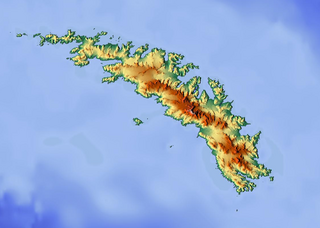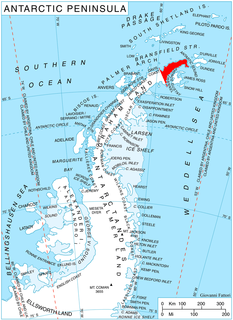
Novosilski Glacier is a glacier, 8 miles (13 km) long and 2 miles (3.2 km) wide, flowing in a westerly direction from the southwest slopes of the Salvesen Range to Novosilski Bay on the south coast of South Georgia. First surveyed and named by a German expedition 1928-29, under Kohl-Larsen. The name derives from nearby Novosilski Bay.
Gjelstad Pass is a pass through the western part of the Allardyce Range of South Georgia, between Mount Corneliussen and Smillie Peak. It is the only pass yet discovered which gives access overland to the area south of the Allardyce Range. It was surveyed by the South Georgia Survey in the period 1951–57, and was named by the UK Antarctic Place-Names Committee for A. Gjelstad, a Norwegian engineer and factory owner, who between 1926 and 1932 invented various devices of great practical value to the whaling industry, including the "whale-claw," an apparatus for grasping the tails of whales for hauling them up the slipways of factory ships.

Graae Glacier is a glacier 2 miles (3 km) long on the north side of Mount Sabatier, flowing west-southwest to Trollhul in the south part of South Georgia. It was surveyed by the South Georgia Survey (SGS) in the period 1951–57, and named by the UK Antarctic Place-Names Committee for Morgens E.W. Graae of Denmark, who developed sledges for the SGS, 1953–54 and 1955–56.
The Wilckens Peaks are a group of mountain peaks, the highest 1,375 m, in the form of an arc which extends from the north side of Keilhau Glacier to the north side of Neumayer Glacier in South Georgia. The peaks were roughly located in 1928-29 by Ludwig Kohl-Larsen who gave the name "Wilckenskette" after Otto Wilckens of Bonn University. An English form of the name has been accepted.

Bertrab Glacier is a small glacier at the head of Gold Harbour, at the east end of South Georgia. It was charted by the Second German Antarctic Expedition, 1911–12, under Wilhelm Filchner, and named by him for General von Bertrab, Chief Quartermaster in the German General Staff and Chief of the Land Survey, who was chairman of the expedition.
Zigzag Pass is a pass through the west portion of Wilckens Peaks in South Georgia, leading from Kohl Plateau to the head of Esmark Glacier. Descriptively named by United Kingdom Antarctic Place-Names Committee (UK-APC) in 1982 from the zigzag folding of the rocks in the pass.

Aitkenhead Glacier is a 10-mile (16 km) long glacier flowing east-southeast from the Detroit Plateau, Graham Land, into Prince Gustav Channel. It was mapped from surveys by the Falkland Islands Dependencies Survey (FIDS) (1960–61), and named by the United Kingdom Antarctic Place-Names Committee for Neil Aitkenhead, a FIDS geologist at Hope Bay (1959–60).

Christensen Glacier is a glacier 4 nautical miles (7 km) long, flowing south into the eastern part of Newark Bay on the south coast of South Georgia. It was surveyed by the South Georgia Survey in the period 1951–57, and named by the UK Antarctic Place-Names Committee for Chr. Fred. Christensen, Norwegian naval architect who, in cooperation with the shipowner H.G. Melsom, first solved the practical problems of building a slipway on a whale factory ship by converting the Lancing in 1925; he also made important improvements in the machinery for treatment and extraction of whale products.

Christophersen Glacier is a glacier 8 nautical miles (15 km) long, flowing west into Jacobsen Bight on the south coast of South Georgia. It was surveyed by the South Georgia Survey in the period 1951–57, and named by the UK Antarctic Place-Names Committee for Pedro Christophersen, one of the first Directors of the Compañía Argentina de Pesca which operated the Grytviken whaling station for more than 50 years beginning in 1904.

Harmer Glacier is a glacier 3 nautical miles (6 km) long, flowing southwest from Starbuck Peak to the sea close north of Ranvik, on the south coast of South Georgia. It was surveyed by the South Georgia Survey in the period 1951–57, and named by the UK Antarctic Place-Names Committee for Sir Sidney F. Harmer.

Henningsen Glacier is a glacier 3 nautical miles (6 km) long, flowing southwest to the south coast of South Georgia between Cape Darnley and Rocky Bay. It was surveyed in the period 1951–57 by the South Georgia Survey expedition led by Duncan Carse, and was named by the UK Antarctic Place-Names Committee for Leonard Henningsen, Manager of Tønsbergs Hvalfangeri, Husvik, 1945–50.

König Glacier is a glacier, 3 nautical miles (6 km) long and 1.5 nautical miles (3 km) wide, flowing in a northerly direction from the north side of Neumayer Glacier to the head of Fortuna Bay, South Georgia. It was first surveyed in 1928–29 by a German expedition under Kohl-Larsen, who named it for Austrian mountaineer Felix König, who took part in the Second German Antarctic Expedition, 1911–12, under Wilhelm Filchner.

Lancing Glacier is a glacier 3 nautical miles (6 km) long, flowing south from Mount Corneliussen and Smillie Peak to Newark Bay on the south side of South Georgia. It was surveyed by the South Georgia Survey in the period 1951–57, and named by the UK Antarctic Place-Names Committee for the Lancing, built in 1898, and converted to a whale factory ship in 1923. It was the first factory ship to be fitted with a slipway.

Morris Glacier is a glacier flowing north to the head of Sea Leopard Fjord in the Bay of Isles, South Georgia. it was charted in 1912–13 by American naturalist Robert Cushman Murphy, aboard the brig Daisy, who named it for Edward Lyman Morris, a botanist who was then head of the Department of Natural Science at the Brooklyn Museum.
Mount Baume is a mountain, 1,910 metres (6,270 ft) high, rising midway along the north flank of Novosilski Glacier near the southeast end of South Georgia. It was surveyed by the South Georgia Survey (SGS) in the period 1951–57 and named for Louis C. Baume, a member of the SGS in 1955–56.
Bordal Rock is an isolated rock 1.5 nautical miles (3 km) west-southwest of Trollhul, off the south coast of South Georgia. Positioned by the South Georgia Survey in the period 1951–57, it was named by the UK Antarctic Place-Names Committee for Harald Bordal, a gunner of the Compañía Argentina de Pesca, Grytviken, for several years beginning in 1948.
Frostman Glacier is a broad, low gradient glacier discharging into the south side of Hull Bay just west of the Konter Cliffs, on the coast of Marie Byrd Land, Antarctica. It was mapped by the United States Geological Survey from surveys and U.S. Navy air photos, 1959–65, and was named by the Advisory Committee on Antarctic Names for Thomas O. Frostman, a meteorologist at Plateau Station, 1968.
Early Bluff is a high bluff on the south side of the Kohler Range in Marie Byrd Land, Antarctica. It stands at the east side of Kohler Glacier at the point where this distributary drains northward from Smith Glacier. It was mapped by the United States Geological Survey from surveys and U.S. Navy air photos, 1959–66, and was named by the Advisory Committee on Antarctic Names after Thomas O. Early, a United States Antarctic Research Program geologist with the Marie Byrd Land Survey Party, 1966–67.
Foxtail Peak is a peak, 455 metres (1,500 ft) high, on the north side of Neumayer Glacier, 2 nautical miles (4 km) west of Carlita Bay, South Georgia. It was charted by the Swedish Antarctic Expedition, 1901–04, under Otto Nordenskiöld. It was surveyed by the South Georgia Survey in the period 1951–56 and named by the UK Antarctic Place-Names Committee after the Antarctic foxtail grass slopes of the peak.






